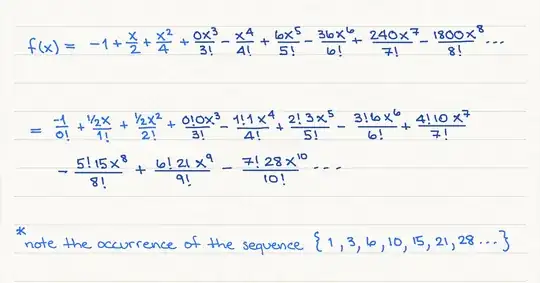The sequence $\{1,36,10,15,21,28,\cdots\}$ is the triangular numbers $\frac{n(n+1)}2$.
So after shifting the indexes we get for $n\ge 3$
$$a_n=-\frac{(-1)^n(n-3)!}{n!}\times\frac{(n-3)(n-2)}{2}=\frac{(-1)^{n+1}(n-3)}{2n(n-1)}$$
We can ignore the first terms $g(x)=-1+\frac x2+\frac{x^2}4$ for the moment and concentrate on the series $h(x)=\sum\limits_{n=3}^\infty a_nx^n$ for now on.
Notice that by derivating twice $\left(\dfrac{x^n}{n(n-1)}\right)''$ we can get rid on the denominator.
$\displaystyle h''(x)=\left(\sum\limits_{n=3}^\infty a_nx^n\right)''=\frac 12\sum\limits_{n=3}^\infty (-1)^{n+1}(n-3)x^{n-2}=\frac 12\sum\limits_{n=0}^\infty (-1)^{n+4}nx^{n+1}$
We would like now to do the opposite, remark that if we factor out $x^2$ we get a group $(nx^{n-1})=(x^n)'$.
But we have to be careful about the first terms and treat them separately, before dividing by $x^2$.
$\displaystyle \begin{align}h''(x)
&=0-\frac 12x^2+\frac 12\sum\limits_{n=2}^\infty (-1)^{n}nx^{n+1}\\
&=-\frac 12x^2+\frac 12x^2\sum\limits_{n=2}^\infty (-1)^{n}nx^{n-1}\\
&=-\frac 12x^2+\frac 12x^2\left(\sum\limits_{n=2}^\infty (-x)^n\right)'\\
&=-\frac 12x^2+\frac 12x^2\left(\dfrac{x^2}{1+x}\right)'\\
&=-\dfrac {x^2}{2(1+x^2)}\end{align}$
This integrates to:
$h'(x)=-\frac 12x+\dfrac {\frac 12}{1+x}+\ln(1+x)+C_1$
$h(x)=-\frac 14x^2+\frac 12\ln(1+x)+\Big[(1+x)\ln(1+x)-(1+x)\Big]+C_1x+C_2$
We have $h(x)=(C_2-1)+(C_1+\frac12)x+O(x^4)$ in a neighbourhood or zero.
This forces $C_2=1$ and $C_1=-\frac 12$ because we want $f(x)=g(x)+O(x^4)$.
Finally:
$$f(x)=\frac 12\ln(1+x)+(1+x)\ln(1+x)-(1+x)$$

